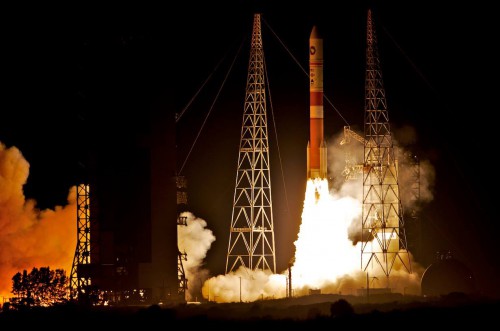
CAPE CANAVERAL, Fla — Barely eight days after it boosted an Atlas V aloft with the GPS IIF-4 satellite, United Launch Alliance (ULA) has successfully returned its workhorse Delta IV rocket to flight, following a lengthy hiatus. Launch took place at 8:27 p.m. EDT Friday May 24, from Space Launch Complex 37 (SLC-37) at Cape Canaveral Air Force Station, Fla., precisely on the opening of a 32-minute “window”. The Delta IV lofted the U.S. Air Force’s fifth Wideband Global Satcom (WGS-5), which is expected to provide a “quantum leap” in military communications capability. It will provide deployed U.S. and allied forces with unprecedented access to bandwidth-intensive applications – such as video streaming, teleconferencing, real-time data transmission and high-resolution imaging – as well as supporting the next generation of unmanned aerial vehicles.
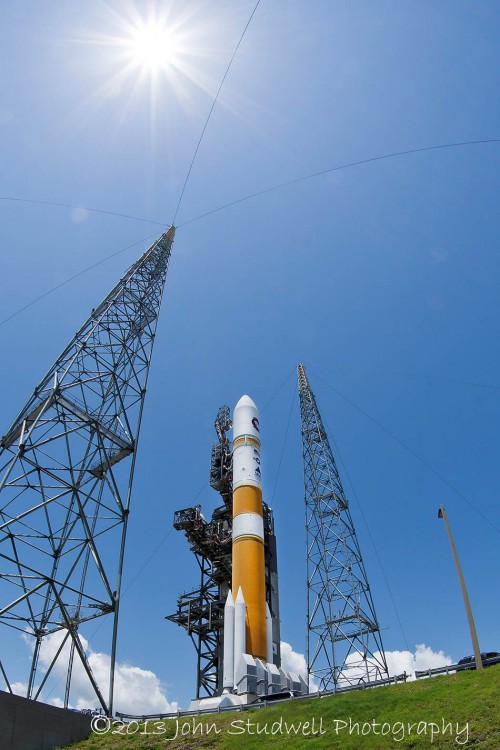
Today’s long-awaited launch comes at the end of seven months of investigation, following a problematic Delta IV launch last October. During last October’s launch, a leak developed on ascent above the narrow-throat portion of the thrust chamber in Pratt & Whitney Rocketdyne’s RL-10B2 upper stage engine. This produced a lower than expected thrust. Fortunately, the low mass of the Delta’s GPS IIF-3 satellite payload, together with a large fuel load and fault-tolerant guidance software, enabled the vehicle to recalculate its trajectory and fire the engine for longer than planned, thus saving the mission from failure. However, this was unacceptable to ULA and its goal of “Perfect Product Delivery” and a joint investigation with Pratt & Whitney Rocketdyne and the U.S. Air Force began.
The investigation team identified the general characteristics of the fuel leak and a number of corrective actions, both in terms of hardware and operational procedures, were implemented. These included thorough inspections of engine and Delta IV systems for damage or the presence of foreign objects, coupled with in-flight helium purges to critical components and changes to how the restartable RL-10B2 is thermally conditioned during ascent to prepare for its first firing. The commonality between the RL-10B2 on the Delta IV and the RL-10A engine on the Atlas V – also operated by ULA – meant that both vehicles were grounded, pending a resolution of the problem. However, while the Delta IV investigations continued, an Atlas V successfully delivered the U.S. Air Force’s X-37B spacecraft into orbit without incident on Dec. 11, 2012. Not until earlier this month did ULA and the Air Force finally give the Delta IV a clean bill of health.
Today’s Delta mission flew in its Medium+ “5,4” configuration, one of five variants of the Boeing-designed rocket. It boasts a 5-meter-wide (16-foot) payload fairing and a modified second stage with a 5-meter liquid hydrogen tank and “stretched” liquid oxygen tank, together with four strap-on Graphite Epoxy Motors (GEM)-60, built by Alliant TechSystems (ATK). The 53-foot-tall GEM-60 is a high-performance, solid-fueled motor, so numbered because its casing measures 60 inches in diameter. The Medium+ 5,4 vehicle has the potential to transport up to 14,475 pounds of payload into a 22,000-mile geosynchronous orbit.
Both the first and second stages for today’s mission were fabricated by ULA at its Decatur, Ala., facility, after which they were delivered separately to Cape Canaveral via the M/C Delta Mariner cargo vessel. Upon arrival at the launch site, final assembly of the stages was conducted inside the seven-story Horizontal Integration Facility (HIF) at SLC-37, after which the Delta was transferred to the pad on Wednesday morning atop a diesel-powered Elevating Platform Transporter. Once it was “hard down” on the SLC-37 surface, a Fixed Pad Erector raised the vehicle into a vertical position within the Mobile Service Tower (MST). The latter – which was retracted on Thursday – contains a crane which installed the four GEM-60 motors, the WGS-5 payload and the two-piece (“bisector”) fairing onto the vehicle.
The Delta IV was originally intended for U.S. military purposes. Low demand and high costs forced Boeing in 2003 to remove it from the commercial launcher market. First flown on Nov. 20, 2002 with the Eutelsat 70A commercial communications satellite, it boasts an impressive record, with 22 missions – including today’s flight – to its credit. Of these missions, all but one – the first voyage of the Delta IV Heavy in December 2004, which suffered a premature engine shutdown and failed to deliver its payloads into their correct orbits – have been deemed successful. With the exception of Eutelsat 70A, the Delta IV has lofted a mixture of military and NASA payloads for communications, reconnaissance, early-warning, weather forecasting and navigational purposes.
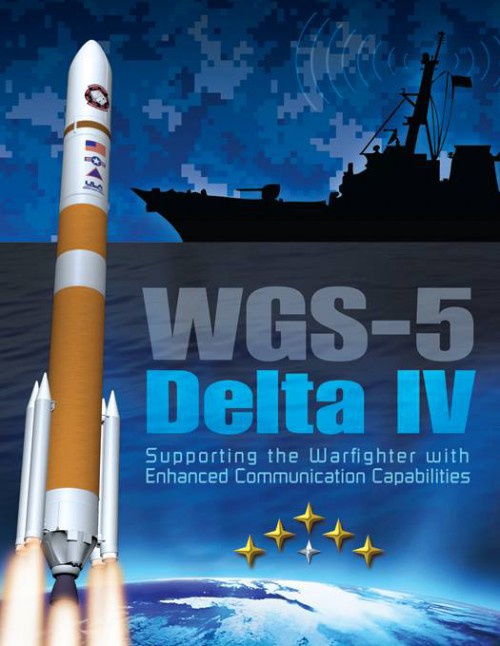
In the Medium+ 5,4 configuration, the rocket’s first stage is a single Common Booster Core (CBC), propelled by Pratt & Whitney Rocketdyne’s RS-68 engine. When this was introduced in 2002, it became the first large liquid-fueled powerplant to be developed by the United States since the Space Shuttle Main Engine. Loading of liquid oxygen and hydrogen propellants into the CBC for Friday’s opening launch attempt required a complex, 4.5-hour procedure, terminating a little over two hours before liftoff. Ignition of the RS-68 occurred at T-5 seconds, enabling the engine to ramp up to its full 663,000 pounds of rated thrust. After telemetry data had confirmed that the engine-start sequence was satisfactory, the four GEM-60 motors roared to life at T-0.01 seconds and the 217-foot-tall Delta departed the launch pad in a blaze and crackle at precisely T-zero.
Shortly after clearing the SLC-37 tower, it executed a computer-commanded pitch, yaw and roll program maneuver to establish itself onto the proper 100.9-degree flight azimuth for delivery of the WGS-5 satellite into orbit. About 50 seconds into the ascent, the Delta burst through the sound barrier and pressed on towards orbit, under the combined impulse of the RS-68 and solids. A minute and a half after launch, the GEM-60s exhausted their propellant and were jettisoned in pairs at T+100 seconds and T+102 seconds. A little over two minutes later, the payload fairing was jettisoned and the CBC completed its portion of the boost to orbit and separated from the vehicle.
“ATK’s extensive involvement with this launch is indicative of the company’s broad capabilities in the aerospace and space markets,” said Blake Larson, president of ATK Aerospace Group. “We are pleased to continue our strong relationships with our customers on this mission.”
The turn then came for the Delta’s cryogenic second stage and its single hydrogen/oxygen-fueled RL-10B2 engine, capable of 24,750 pounds of thrust. This engine features an extendable carbon-carbon nozzle to enhance its specific impulse and completed two critical “burns” to inject WGS-5 into its operational orbit. The first of these firings began at T+267 seconds, about 13 seconds after the separation of the CBC. It burned for about 16 minutes and established the satellite into its “parking” orbit, after which it coasted for eight minutes, ahead of a second burn, which got underway at T+28 minutes. The second firing was shorter – about three minutes in duration – and WGS-5 separated at T+41 minutes. By this stage, the satellite was in geosynchronous transfer orbit, with a perigee of 238 nautical miles and an apogee of 36,134 nautical miles, inclined 24 degrees to the equator.
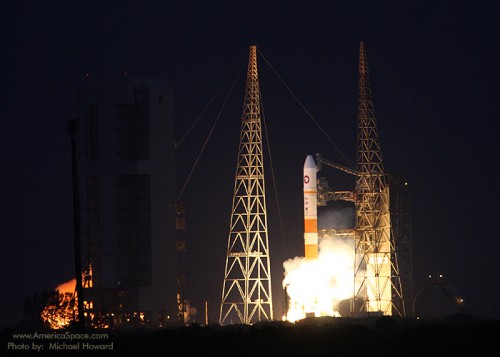
Weighing 13,200 pounds, WGS-5 is the latest in a series of high-capacity communications satellites, operated by the Air Force Space Command’s Space and Missile Systems Center. It supports communications links in the 500 MHz range of the X-band and 1 GHz range of the Ka-band and has the capacity to filter and route up to 4.875 GHz of instantaneous bandwidth. The new satellite includes a high-bandwidth radio frequency bypass capability and can support data-transmission rates between 2.4 and 3.6 Gbps, some three times faster than previous DoD systems. It is also equipped with a xenon-ion propulsion system, which offers a tenfold efficiency improvement over conventional bipropellants, and carries triple-junction gallium arsenide solar cells and deployable radiators with flexible heat pipes. A single WGS is believed to possess as much bandwidth as the entire Defense Satellite Communications System (DSCS) network currently in service. Following agreements signed in November 2007, the WGS system will be operated in partnership between the Department of Defense and the Australian Defence Force. Canada is also a partner in the project.
“This satellite is going to strengthen an important tool that warfighters count on to be successful and safe,” said Boeing’s Vice President and General Manager of the company’s Space & Intelligence Systems – Craig Cooning.
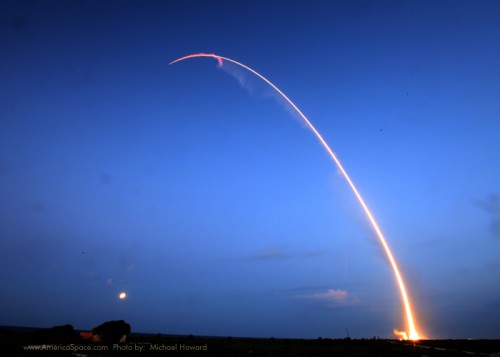
Three “Block 1” satellites – WGS-1, 2 and 3 – were launched into orbit between October 2007 and December 2009, providing complete strategic coverage of the Pacific and Atlantic Oceans and supporting U.S. Central Command in Afghanistan, Iraq and western Asia. The first member of the upgraded “Block 2” network, WGS-4, flew atop an Atlas V from Cape Canaveral Air Force Station in January 2012. A sixth satellite (WGS-6) was transported to Florida from Boeing’s production facility in El Segundo, Calif., on 17 May 2013, ahead of its scheduled launch from SLC-37 later this summer. Boeing is currently working on the development of a seventh WGS, having received a $182 million contract from the Air Force for the construction of follow-on satellites in August 2010.
Today’s triumphant return to flight for the Delta IV returns the vehicle to operational status, with two further missions scheduled this year. In August it will loft WGS-6 and in October it will transport GPS IIF-5, both from Cape Canaveral. Speaking earlier this month, Jim Sponnick, ULA’s vice president for Mission Operations, noted that “extensive analyses and engine testing, along with the mitigating actions that have been implemented” had increased confidence that “the risks have been mitigated.”
Want to keep up-to-date with all things space? Be sure to “Like” AmericaSpace on Facebook and follow us on Twitter:@AmericaSpace




3 Comments
3 Pings & Trackbacks
Pingback:Is The Future Bright for Aerojet Rocketdyne? « AmericaSpace
Pingback:Delta IV Launches High-Capacity WGS-6 Military Communications Satellite « AmericaSpace
Pingback:Faulty Valve Replacement Delays ULA’s Next Delta IV Launch « AmericaSpace